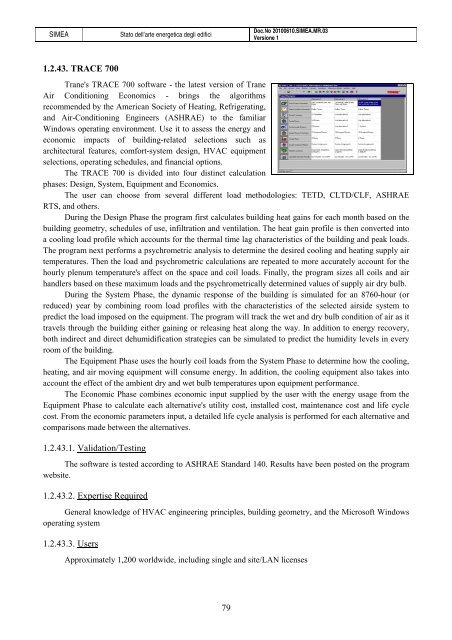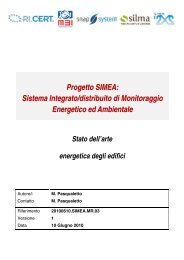Progetto SIMEA - Automatica - Università degli Studi di Padova
Progetto SIMEA - Automatica - Università degli Studi di Padova
Progetto SIMEA - Automatica - Università degli Studi di Padova
Create successful ePaper yourself
Turn your PDF publications into a flip-book with our unique Google optimized e-Paper software.
<strong>SIMEA</strong> Stato dell’arte energetica <strong>degli</strong> e<strong>di</strong>fici<br />
1.2.43. TRACE 700<br />
79<br />
Doc.No 20100610.<strong>SIMEA</strong>.MR.03<br />
Versione 1<br />
Trane's TRACE 700 software - the latest version of Trane<br />
Air Con<strong>di</strong>tioning Economics - brings the algorithms<br />
recommended by the American Society of Heating, Refrigerating,<br />
and Air-Con<strong>di</strong>tioning Engineers (ASHRAE) to the familiar<br />
Windows operating environment. Use it to assess the energy and<br />
economic impacts of buil<strong>di</strong>ng-related selections such as<br />
architectural features, comfort-system design, HVAC equipment<br />
selections, operating schedules, and financial options.<br />
The TRACE 700 is <strong>di</strong>vided into four <strong>di</strong>stinct calculation<br />
phases: Design, System, Equipment and Economics.<br />
The user can choose from several <strong>di</strong>fferent load methodologies: TETD, CLTD/CLF, ASHRAE<br />
RTS, and others.<br />
During the Design Phase the program first calculates buil<strong>di</strong>ng heat gains for each month based on the<br />
buil<strong>di</strong>ng geometry, schedules of use, infiltration and ventilation. The heat gain profile is then converted into<br />
a cooling load profile which accounts for the thermal time lag characteristics of the buil<strong>di</strong>ng and peak loads.<br />
The program next performs a psychrometric analysis to determine the desired cooling and heating supply air<br />
temperatures. Then the load and psychrometric calculations are repeated to more accurately account for the<br />
hourly plenum temperature's affect on the space and coil loads. Finally, the program sizes all coils and air<br />
handlers based on these maximum loads and the psychrometrically determined values of supply air dry bulb.<br />
During the System Phase, the dynamic response of the buil<strong>di</strong>ng is simulated for an 8760-hour (or<br />
reduced) year by combining room load profiles with the characteristics of the selected airside system to<br />
pre<strong>di</strong>ct the load imposed on the equipment. The program will track the wet and dry bulb con<strong>di</strong>tion of air as it<br />
travels through the buil<strong>di</strong>ng either gaining or releasing heat along the way. In ad<strong>di</strong>tion to energy recovery,<br />
both in<strong>di</strong>rect and <strong>di</strong>rect dehumi<strong>di</strong>fication strategies can be simulated to pre<strong>di</strong>ct the humi<strong>di</strong>ty levels in every<br />
room of the buil<strong>di</strong>ng.<br />
The Equipment Phase uses the hourly coil loads from the System Phase to determine how the cooling,<br />
heating, and air moving equipment will consume energy. In ad<strong>di</strong>tion, the cooling equipment also takes into<br />
account the effect of the ambient dry and wet bulb temperatures upon equipment performance.<br />
The Economic Phase combines economic input supplied by the user with the energy usage from the<br />
Equipment Phase to calculate each alternative's utility cost, installed cost, maintenance cost and life cycle<br />
cost. From the economic parameters input, a detailed life cycle analysis is performed for each alternative and<br />
comparisons made between the alternatives.<br />
1.2.43.1. Validation/Testing<br />
The software is tested accor<strong>di</strong>ng to ASHRAE Standard 140. Results have been posted on the program<br />
website.<br />
1.2.43.2. Expertise Required<br />
General knowledge of HVAC engineering principles, buil<strong>di</strong>ng geometry, and the Microsoft Windows<br />
operating system<br />
1.2.43.3. Users<br />
Approximately 1,200 worldwide, inclu<strong>di</strong>ng single and site/LAN licenses
















